Exploring New Age & Indigenous Cultures
Reflecting on Shamanism, the Lakota ways, and self-expressive drumming/writing
All Glory to Sri Guru and Sri Gauranaga
Namaste! After two years of following the herd in college, I decided to take a leave of absence due to a lack of clarity in my direction and a growing dissatisfaction with the typical college experience. Upon returning to my parents’ house in Eatontown, I began working as a barista at Starbucks and exploring alternative life paths. Due to a combination of a lifelong attraction to the mystical and possessing childish naivete (for you skeptics out there, being attracted to the mystical is not inherently naive), I sought guidance from the psychic a block away from home. The lady at Madame Marie’s was able to squeeze a total of $600 out of me over a month or two, before I recognized that I wasn’t making progress in clarity or satisfaction.
Not long after that, I came across shamanic practitioners who operated a spiritual healing practice out of their home, which, coincidentally, was also a block away from my parents’ house but in the opposite direction from the psychic. These men, Al and Adam, were respected in Monmouth County’s spiritual community due to owning the Sacred Circle New Age Center, a beloved community hub in Long Branch that burned down in 2012. As tragic as the burning of their center was, if it hadn’t happened, then they might not have been actively practicing out of their home when I encountered them in 2014. Adam and Al had compassion for me as a young seeker, and, for the most part, allowed me to engage in their shamanic healing sessions through bartering with garden work rather than spending money I didn’t have. These sessions entailed therapeutic heart-to-heart discussions and counsel, as well as what might be called “energy healing.” Whether or not these energy healings had a tangible effect on me is hard to say, but the communal aspect of participating in their programs became a vital aspect of my formative experiences through 2017. I became surrounded by people who were embracing indigenous wisdom from Peruvian, Tibetan Bon (pre-Buddhist), and Lakota traditions, allowing the study and application of it to guide their lives. It was enlivening for my 20-year-old self to associate with people who led productive lives in society and also took spirituality seriously.
Comparative Theology: Lakota & Vaishnava
During one of my sessions with Al, he mentioned the White Buffalo totem, an archetype representing a bridge between the material and spiritual planes of reality. Later, through attending numerous (tobacco) pipe ceremonies at Adam and Al’s, I learned more about the Lakota’s story of the White Buffalo Calf Woman as a sacred figure who revitalized a degraded culture’s respect and love for all living entities as well as their connection with Great Spirit (Wakan Tanka). This excerpt from the Lakota Times summarizes the story as told by Chief Arvol Looking Horse:
Walking clockwise around the altar of sage and cherry branches, she set down the Sacred Bundle in the altar, then opened it to reveal the sacred ca.nu.pa. She told them, “This ca.nu.pa, you will make direct personal contact with Waka. Ta.ka..” She said, “Following the way of this sacred ca.nu.pa, you will walk in a sacred way upon the Earth, for the Earth is your grandmother and your mother and she is sacred.” She told them, “The red stone of the ca.nu.pa’s bowl represents the blood of the People, and it also represents the female. And the wooden stem represents the Tree of Life, and it also represents the male. The Tree of Life also represents the root of our ancestors, and as this Tree grows so does the spirit of the people.” She said “When you put the ca.nu.pa’s bowl and stem together, you connect the world above and the world below. The only time the ca.nu.pa is put together is when you are in prayer. And when you pray with the ca.nu.pa, humble yourself. Present your prayers to all 4 Sacred Directions, and then pray to the Great Spirit above and Mother Earth below. Sing your songs and pray for life, peace, harmony and happiness.”
She warned, “You must have a good heart and a good mind to go to the ceremonies. Honor the Sacred Places, the Sacred Ceremonies, and the Sacred Sites. Each Sacred Site is an altar to the Great Spirit. Gather there often and pray the prayers and sing the songs I have taught you. In time, you will understand the meaning of the Seven Sacred Rites that come with this sacred bundle.” She left in a clockwise motion returning to where the sunsets. On top of the hill, she stopped and looked back, then rolled over and became a young beautiful black buffalo. The second time she was a red buffalo, then a yellow buckskin buffalo, and finally a white buffalo.
There are some interesting similarities between the Lakota and Vaishnava perspectives. First is the deep regard for bovine, where the Lakota consider buffalo sacred and the Vaishnavas revere cows. The Lakota consider the buffalo a gift from Great Spirit for the sustenance of their people, and after hunting buffalo, every aspect of the animal is utilized for food, clothing, tools, etc. These Native Americans considered the buffalo their kin, and upon killing one, they would honor it by saying, “Dear brother, this time I have taken your life, and next lifetime you will take mine.” Sripad Bhakti Madhava Puri Maharaja has given honor to their attunement to material nature, such that Natives intuitively recognized the law of karma (action and reaction), which prompted their respect and harmony with nature’s rhythms. An aspect of ancient Vaishnava culture is not only to revere cows, but also to protect them. The cow is seen as the milk-giving mother who nourishes us, and is seen as nondifferent from Mother Earth, who also nourishes us with sufficient food grains and natural resources. Cow urine (gomutra) even has medicinal value, and the dung can be used as fertilizer and fuel. While both cultures view bovines as sacred sources of abundance, it is important to note that Vaishnavas are vegetarian and do not consume meat. The abundance that cows produce relies on their living in a happy and healthy condition, and cow protection strives to facilitate this.
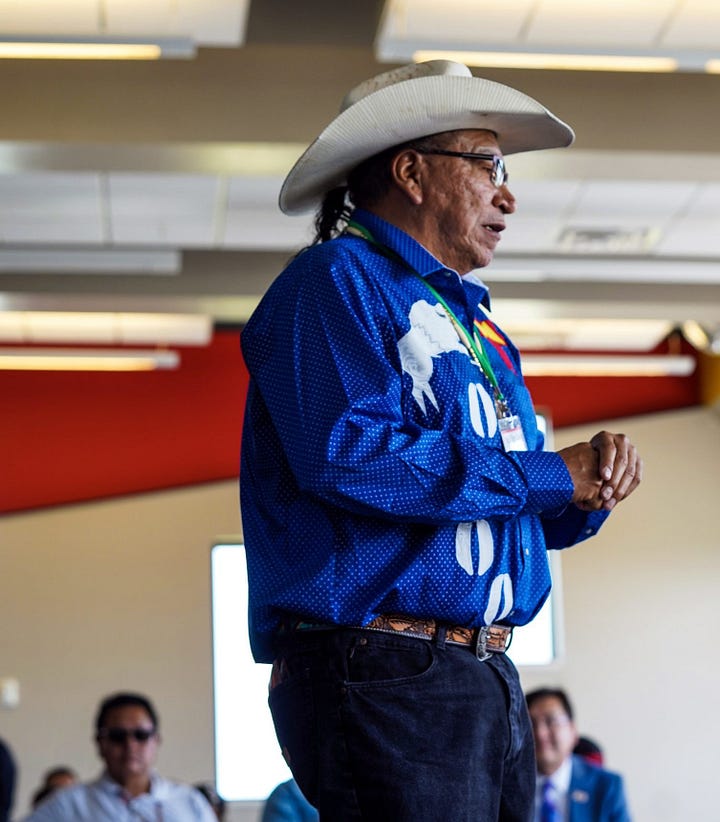
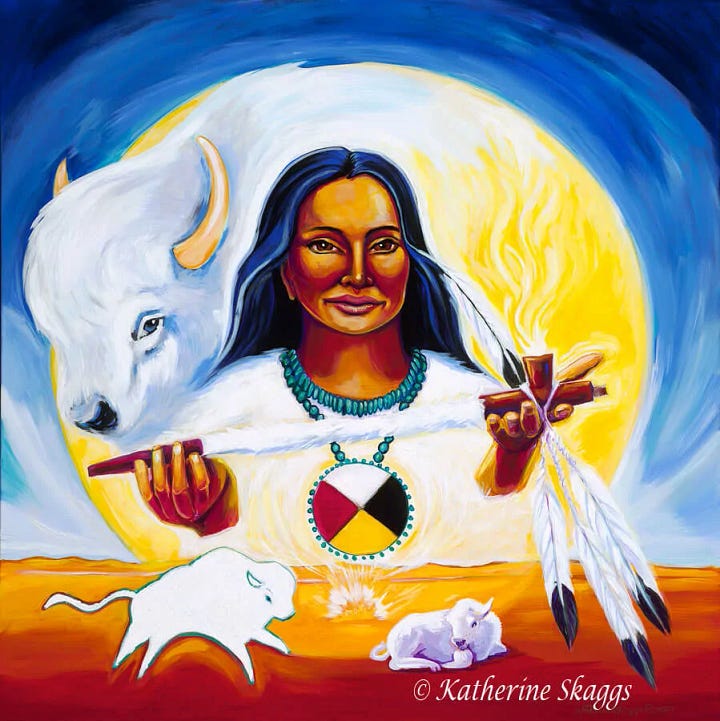
At the end of the story of the White Buffalo Calf Woman, she transformed into different colored buffalo: black, red, yellow, and white. These colors also belong to the Medicine Wheel, which is accepted by many different Native American tribes. Interestingly, these colors also hold special significance for the Vaishnavas. In his purport to Bhāgavatam 1.3.5, Śrīla Prabhupād explains:
“Then there are the yugāvatāras, or the incarnations of the millennia. The yugas are known as Satya-yuga, Tretā-yuga, Dvāpara-yuga and Kali-yuga. The incarnations of each yuga are of different color. The colors are white, red, black and yellow. In the Dvāpara-yuga, Lord Kṛṣṇa in black color appeared, and in the Kali-yuga Lord Caitanya in yellow color appeared.”
Śrīmad-Bhāgavatam 10.8.13 directly affirms the four colors of Kṛṣṇa’s incarnations:
āsan varṇās trayo hy asya
gṛhṇato ’nuyugaṁ tanūḥ
śuklo raktas tathā pīta
idānīṁ kṛṣṇatāṁ gataḥ
“Your son Kṛṣṇa appears as an incarnation in every millennium. In the past, He assumed three different colors — white [śuklaḥ], red [raktaḥ], and yellow [pītaḥ] — and now He has appeared in a blackish color [kṛṣṇatām].”
It is not my place to speculate on the deeper meaning of these colors within either spiritual culture, or whether the similarity may have similar roots, or if it is purely coincidental. It just always struck me, so I figured I’d share. Another, perhaps more meaningful similarity between Lakota and Vaishnavism is referring to Great Spirit (Wakan Tanka) as Grandfather or Great Grandfather (Tunkashila). In Bhagavad-gītā 11.39, Kṛṣṇa is also referred to as Great Grandfather (prapitāmaha).
vāyur yamo ’gnir varuṇaḥ śaśāṅkaḥ
prajāpatis tvaṁ prapitāmahaś ca
namo namas te ’stu sahasra-kṛtvaḥ
punaś ca bhūyo ’pi namo namas te
“You are air, and You are the supreme controller! You are fire, You are water, and You are the moon! You are Brahmā, the first living creature, and You are the great-grandfather. I therefore offer my respectful obeisances unto You a thousand times, and again and yet again!”
Śrīla Prabhupād explains further:
“Because Kṛṣṇa is the original person, therefore He must be Purāṇa, the oldest, older than Brahmā. Because Brahmā is given birth by Kṛṣṇa. Therefore Kṛṣṇa has been addressed in the Bhagavad-gītā as prapitāmaha (BG 11.39). Brahmā is called pitāmaha, the grandfather, and prapitāmaha means "the father of the grandfather." So Kṛṣṇa has been addressed as prapitāmaha, "father of Brahmā." Therefore He's ādi-puruṣa. Actually, within this creation, Lord Brahmā is the original person, because he was firstborn. There was no other person before him. But he's given birth by Nārāyaṇa, from the abdomen of Nārāyaṇa in the lotus flower. Therefore He’s the father of Brahmā. Prapitāmaha.”
The final comparative point that I’ll address is the Lakota practice of becoming a hollow bone, which loosely corresponds to the Vaishnava conception of śaraṇāgati, complete self-surrender to Kṛṣṇa. Frank Fools Crow, a Lakota medicine man, explained that “The one who wishes to be a true medicine person must be a person of faith, and they can only work successfully with those who also have faith” and “When we become hollow bones, there is no limit to what the Higher Powers can do in and through us in spiritual things.” This condition of becoming a surrendered instrument of the will of Spirit is also referred to as nimitta-mātram in Bhagavad-gītā 11.33.
Self-Expression Through Writing & Drumming
During my time closely associating with Al and Adam, I attended two summer retreats that sandwiched my return to Stockton University after the leave of absence. These retreats exposed me to an even wider circumference of Sacred Circle community members, such as Shana and Jeff. These nice folks graduated from Adam and Al’s shamanic practitioner apprenticeship and held personal development programs out of a beautiful Mongolian yurt in South Jersey. Upon returning to complete my third year at Stockton, where I changed from a Sustainability major and Holistic Health minor to a Philosophy/Religion major and Writing minor, I lived at a friend’s house, which was less than a 30-minute drive from Shana and Jeff’s yurt.
After a year of discovering the alternative life paths of other people, such as Shamanism, Paganism, Wicca, Reiki, and Human Design, during the 2015/2016 academic year, I started shifting focus to reflecting on what I’d learned from these experiences and how this might help uncover my own path. Gradually becoming accustomed to self-reflective writing through a Creative Nonfiction Workshop class at Stockton and a writer’s group led by Shana at the yurt, my introspective writing practice began. Unearthing my innermost thoughts and seeing them on paper, no matter how messy and awkward they were, helped encourage self-expression. I was less afraid to go after things that I thought I wanted, even if this meant learning that my initial desire was misguided.
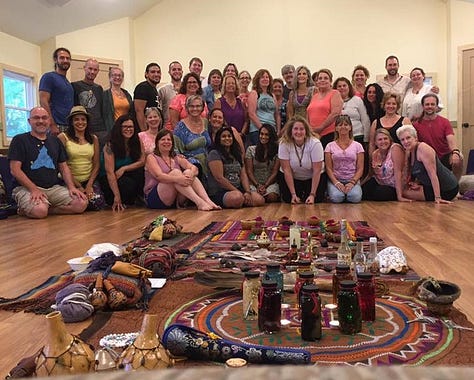
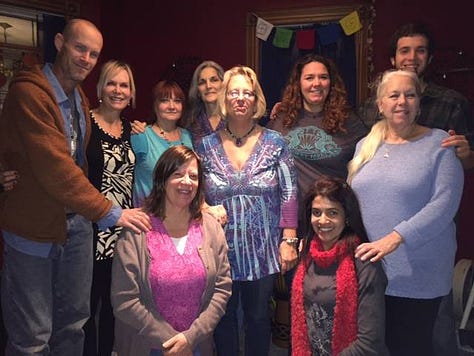
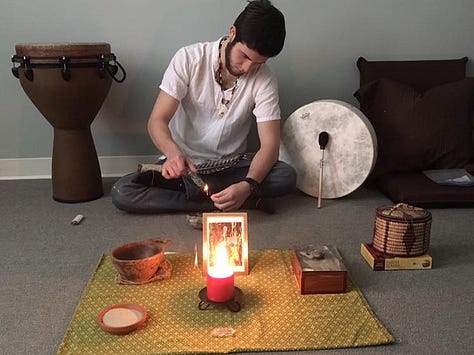
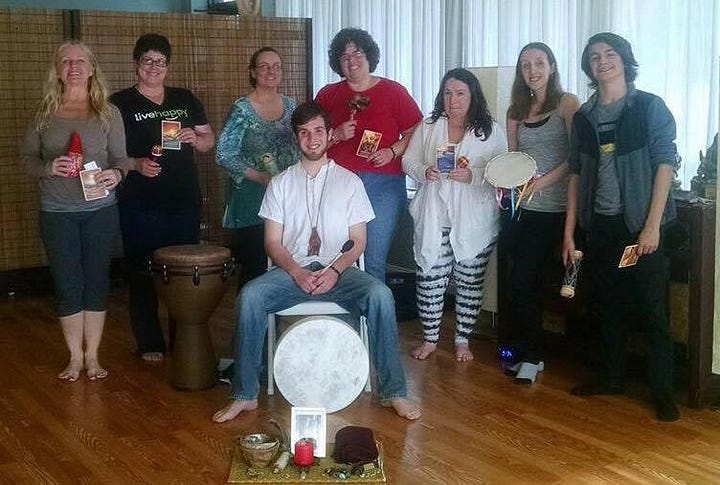

After the second summer retreat with Adam and Al in July 2016, I began to really appreciate rhythmic drumming as a wordless way to express myself and connect with others. As it turned out, after AY 2015/2016, I wouldn’t return to Stockton University until AY 2020/2021. By December 2016, Adam and Al had announced that they were moving from Eatontown to upstate New York, and Al was offering a Healing Rhythms Drum Circle facilitator training so that community drumming would continue throughout New Jersey. Al’s training helped me to consistently adopt a regular drumming practice that I’d eventually share throughout Monmouth County via programs like the Downtown Freehold drum circle. This would eventually translate to the devotional practice of playing the mridanga, which is still proving to be an exceptionally long learning curve for me.
Around this time, I also began practicing Hatha yoga quite seriously, which would eventually lead me to the path of Bhakti-yoga. My misconceptions about seeking deep inner fulfillment through exploitative or mundane relationships would also be thoroughly tested, resulting in valuable lessons. After Al’s drum circle training in December 2016, it would be just about two years before I moved into my Guru’s ashram. During those years, I trained in Ayurveda and Hatha yoga, began dabbling in gardening, formally studied Lakota Sacred Teachings, and started a wellness business. Most of these will be discussed in the next couple of blog posts. The Lakota Sacred Teachings were the culmination of my experience with the Sacred Circle community. These teachings involved a six-month course taught by a bonafide Lakota spirit woman, and ended with a traditional Vision Quest on my 23rd birthday. After experiencing this purifying ritual, the Lakota woman offered me some parting counsel. She knew that I was exploring Vedic (Yoga/Ayurveda) and Lakota teachings simultaneously and welcomed me to engage further in the Lakota ways. However, she advised that to make proper spiritual progress, I should decide on one tradition to devote myself to. It was at this time, before I knew anything about the more profound teachings of the Vaishnavas, that I committed myself to pursuing Vedic wisdom, as this was the source of my deepening inner fulfillment and ever-expanding hankering.
Mitakuye Oyasin
Sri Krishna Sharanam Mamah
Lakota books:
The Sacred Pipe: Black Elk’s Account of the Seven Rites of the Oglala Sioux (1953)
White Buffalo Teachings from Chief Arvol Looking Horse (2001)






